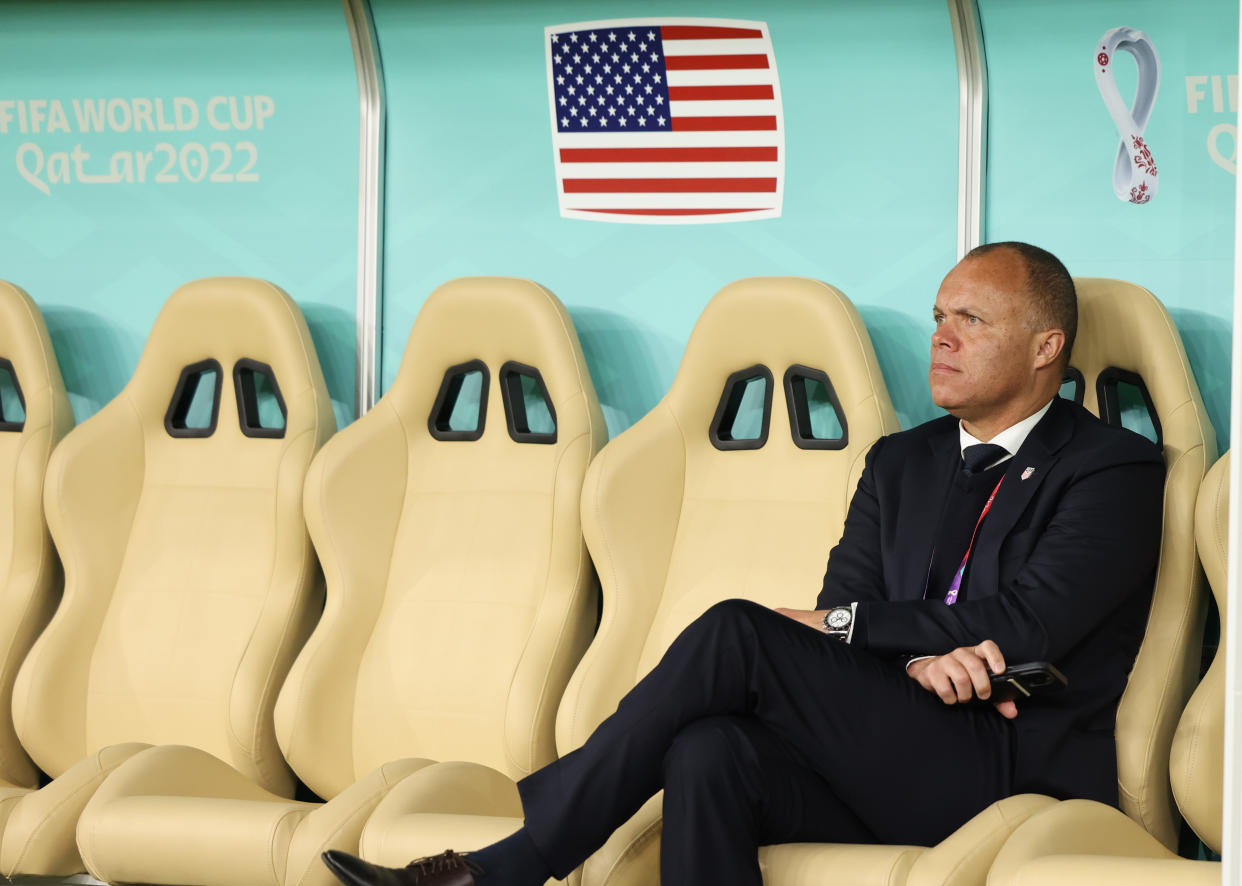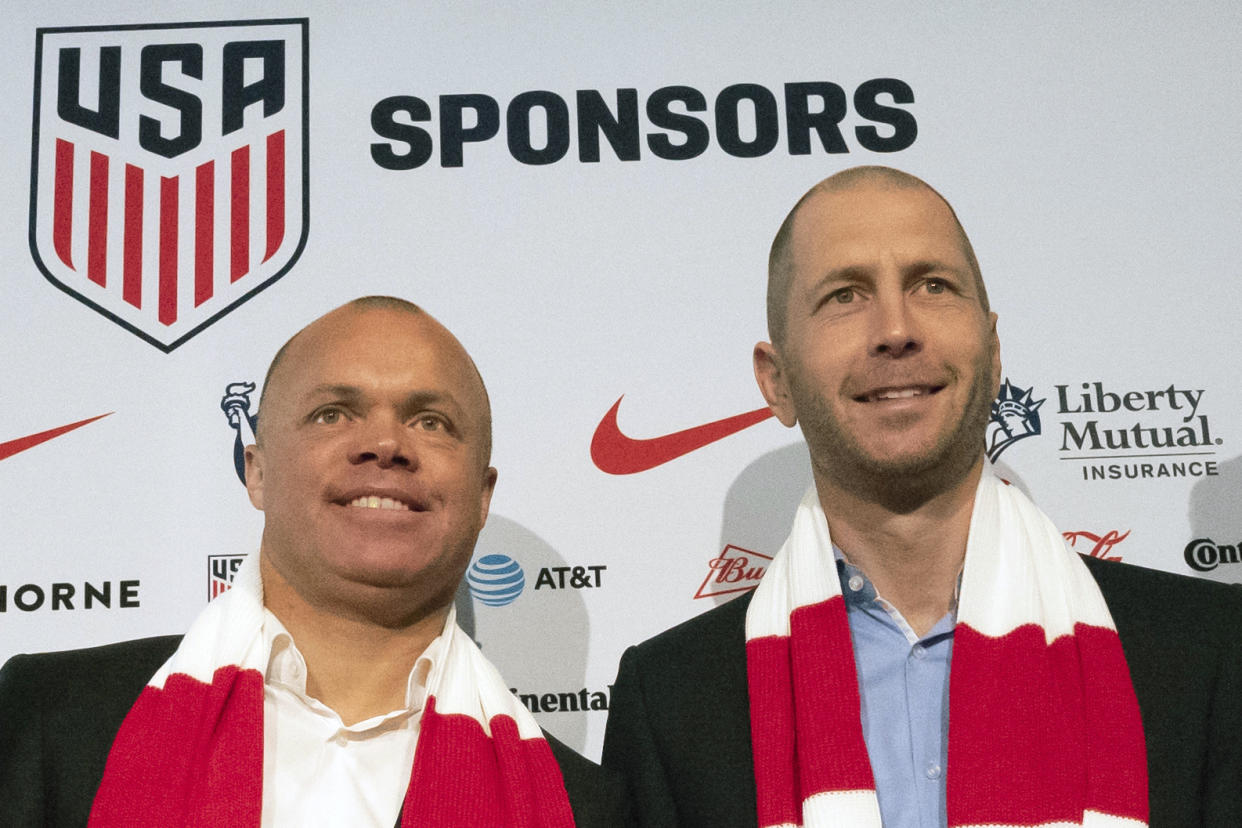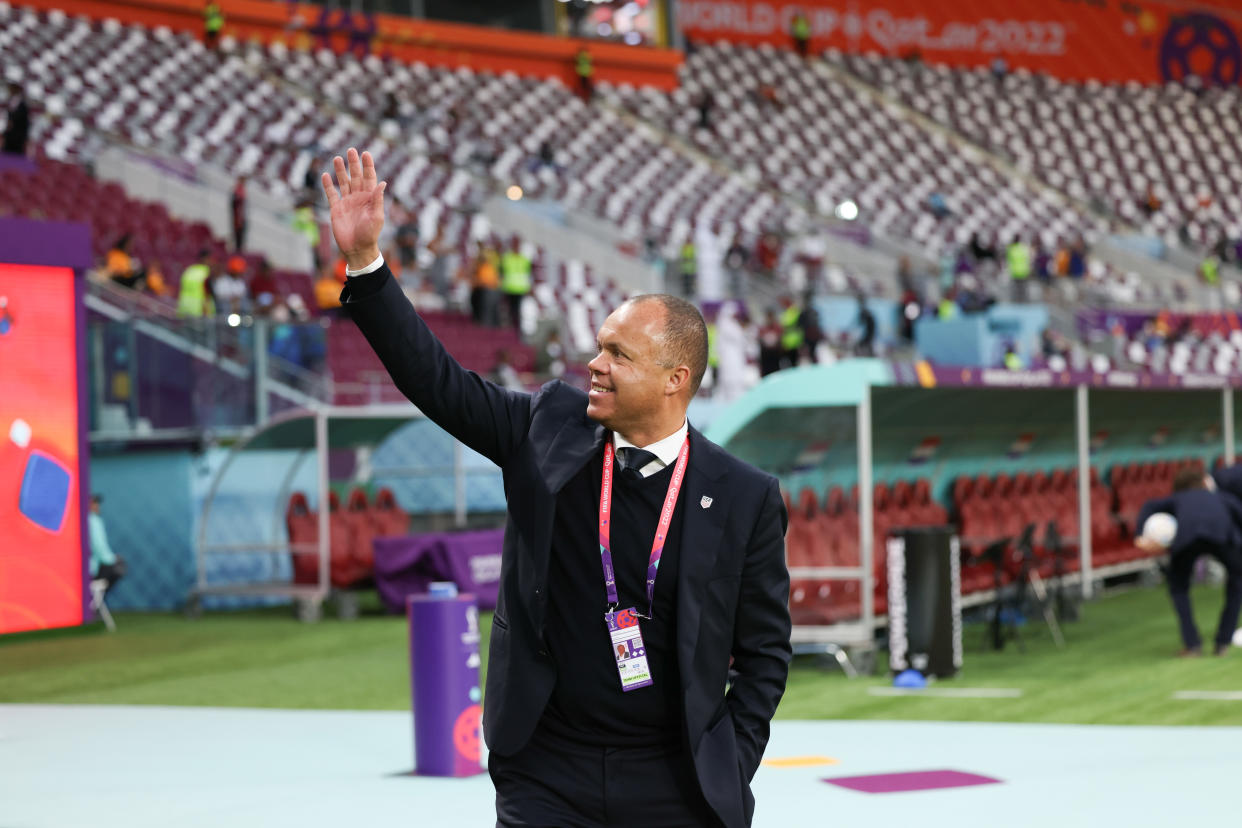Earnie Stewart, U.S. Soccer’s outgoing sporting czar, is leaving behind a vision

Earnie Stewart pulled up the PowerPoint. He was in his final week at U.S. Soccer, but was still sipping espresso on an early morning in downtown Chicago, and was in no mood to reminisce. He has a new job, and an upcoming trans-Atlantic move, but he hadn’t yet packed up his one-bedroom apartment. And he still had a vision for the future of American soccer. He made a personal decision to step away from it, but inside his head, and on the screen, it still existed.
You see, Stewart said, “we had a good [2022] World Cup. ... But the difference between being a good team and a great team is also having individuals that can change a game in a short moment.”
He was speaking, of course, about the U.S. men’s national team and the Round of 16 game that ousted them. He thinks that if a neutral observer had watched every moment of it except for the goals, they’d assume the USMNT had the upper hand. It instead ended 3-1 to the Netherlands, because of those “individuals” — individuals whom Stewart, in his role as U.S. Soccer sporting director, couldn’t do much to influence or shape.
Which is why, behind the scenes, throughout his few years in the role, he broadened its scope.
“I think we need to develop a different type of player,” Stewart told Yahoo Sports over Zoom earlier this month. “You need creative players that are capable of creating [dangerous] situations, creating goalscoring opportunities. … But that starts at an earlier age. Like, the cognitive skills, the decision-making, the creativeness — that doesn't come at 15 or 16. You have it then, or you don't have it.”
So, although public perceptions of his job centered on a single coach that he hired — which we’ll get to — his role had evolved. As USMNT general manager in 2018-19, his task was “stabilizing the program” when “it was at an all-time low,” he explained. Then he became sporting director, and that changed. He oversaw the implementation of his vision across all of U.S. Soccer’s youth and senior national teams. He managed 11 direct-reports, experts in everything from coaching education to high performance, and entrusted them with instilling a “style of play, a DNA, roles and responsibilities, data collection, position-specific profiles.” From U-15 boys to USWNT and in between, he believes, they largely did that.
All the while, though, without much public fanfare, Stewart branched out. He wanted to bring these principles to the entire American youth soccer pipeline, to a convoluted web of clubs and acronyms and sanctioning organizations that actually develop the vast majority of players — but that U.S. Soccer, the sport’s national governing body, only tangentially controls.
“And that is, I'll honestly say, a very difficult part in the United States,” Stewart said. “Because we have a very — um — complex landscape.”
Along the way, he encountered challenges that speak to the uniqueness of the job he’s vacating. He “loved it,” and saw it as a professional pinnacle, but others might not. To make meaningful change, he had to venture out into the broader soccer ecosystem and try to mold the environments in which kids across America learn the game. “At a club, if you wanna change something tomorrow, you just tell everybody that you're changing it,” he said. “Here … you need to convince people.”
And while many of his potential successors currently obsess over buying and selling players and winning week-to-week at professional clubs, Stewart couldn’t do any of that. Technically, he couldn’t even choose national team coaches — that, he said, would be the responsibility of USWNT GM Kate Markgraf and would have been the responsibility of USMNT GM Brian McBride, if McBride hadn’t decided to leave his post. (Stewart and his bosses, though, would be involved in discussions.)
And no, Stewart hasn't left a list of USMNT coaching candidates on his desk for his eventual replacement to inherit. He also declined to speak about where he was going with the coaching search before his departure. “I can't say that right now,” he said. “And I'd burden somebody else with my thoughts, and that's not what I'm going to do.” (Stewart also said he couldn’t address anything related to the Berhalter-Reyna investigation.)
What he would say about Gregg Berhalter, his first hire, is this: “Somebody should be judged on the results that they get and the process that they put in place. And … as I've reviewed it with him, that's the piece that I was really happy with over the past four years.
“The best part about anything is, when I got to the World Cup, and was amongst that group, that there was a real, strong feeling in this group that they could win against everybody. That is something that I think is so powerful. And that is something that didn't happen just overnight, that's something that Gregg and his staff worked on for a long period of time. And I think he did an amazing job of that, in creating that culture. And is everything perfect that we did? No. ... I don't think that's ever going to be the case. But I think he's done a really good job.”

Stewart's vision for U.S. Soccer youth development
Now, back to the vision, to the “next step,” to creating the “next player,” the type that will someday take the USMNT beyond where it currently is, long after Stewart’s departure. This is part of what had come to consume him long before the 2022 World Cup. This is how he interpreted the sporting director role. This is why he’d walk to work in the 7 a.m. hour and not leave until evening. He drinks “probably 8-9 espressos a day.”
He wanted to restructure American soccer. He wanted to create a true pyramid. He knows there are plenty of powerful people throughout the sport who think that’s impossible, or at least not feasible — “it’s not gonna happen,” one youth executive told Yahoo Sports — to which he’d say: “Why not?”
The country’s size, Stewart said, “is just an excuse.”
He envisioned a streamlined system where every kid would train with and play against peers with similar levels of ability and commitment. His and American soccer’s problem is that, at many levels of the sport, kids and teams are grouped not just by competitiveness but by organization. There is USYS, and USCS, and AYSO, and others who often compete for market share. There are divergent interests. There are kids and families who drive, or sometimes even fly, past equally talented kids that belong to a different four-letter acronym, just to meet another team under the same acronym.
So the pyramid, Stewart argues, is actually not a pyramid at all. MLS, the NWSL and the USL have done “a really good job” and “taken care of the top layer of professional players,” he said, but underneath them, the base of the pyramid is fractured. Each youth sanctioning organization has its own leagues and its own ladder. Their relationships aren’t necessarily acrimonious, but their agendas and business models and objectives aren’t always aligned.
And there are many who believe they never will be, or that U.S. Soccer isn’t capable of aligning them. Stewart disagreed, and tried, but struggled.
He spoke consistently with U.S. Soccer’s board-level technical development committee, and the task forces below it, and “you just work your way down,” he said. He wanted to break down barriers between the sanctioning organizations. He then wanted to introduce standards at even younger ages. U.S. Soccer’s since-shuttered Development Academy, which was built around standards, became the birthplace for the current USMNT; from age 12 and up, Stewart believes, academies across the country have gotten “really good.” But it’s even earlier when “the creative brain” blossoms. He knows that “standards,” especially at such young ages, is “a scary word,” but there can be “guardrails” that help create fun educational environments.
He could speak for hours about how, exactly, to do that. “Development,” he said, “is my passion.” But development, at least here in the U.S., is now out of his hands, so he wanted to be clear: “This is how I view things. Maybe somebody else has an even better idea.”
Stewart's next step, and his view on U.S. Soccer's
All of that is the vision he left behind on Feb. 15, and one which a new sporting director could override — but Stewart doesn’t foresee that. When I raised the possibility, he almost seemed confounded by the thought.
“Anybody that has development as something that's important to them, I think they're going to view it in the same way, and they're going to see the same things,” he said. “That's the part I'm not afraid of. I know a lot of colleagues, and sporting directors, and technical directors, in Europe and all that I've met here, that have development as a really important piece, and that have lived that every single day. We all think the same way.”

U.S. Soccer’s messaging and apparent approach have struck a somewhat different chord. Federation president Cindy Parlow Cone called the current sporting leadership void a “clean canvas.” The federation has retained Sportsology, a consulting firm, to “take a deep dive into our organization,” Parlow Cone said, and “review our sporting structure,” U.S. Soccer CEO J.T. Batson said. They have hinted at the possibility of significant changes, perhaps to the departments that Stewart oversaw.
So I asked Stewart if he thought anything structurally within the federation needed to change going forward.
“Within the federation? ... No. I don't,” he said.
But he also knows that those decisions aren’t his.
His decision to leave, he and others have said, was a personal one. He is going home, to PSV Eindhoven, 20 minutes from where he grew up — and 20 minutes from where his parents and mother- and father-in-law still live. His son is in college now. His daughter recently graduated. He and his wife are “probably” going to sell their house in the north of Holland and move down south, close to parents, close to Stewart’s new club, and close to where his globetrotting life began.
He’ll leave the U.S. having “met a lot of amazing people” and having “gained friends for life.” I asked him if he’s proud of what he accomplished, but “nah,” he said, “no. That's just not me.” He is notoriously businesslike and unemotional, always on the run toward his next challenge. His accomplishments, he said, are “not important. It's more of, what are the things we still need to accomplish?”
But there was one moment that struck him. It wasn’t a World Cup or a win; it was his very first U.S. Soccer board meeting. He thought, at the time, about how “a small kid from Uden in Holland with an American father and a Dutch mother was sitting at a board table in Chicago talking about the direction of soccer in the United States.”
“I mean, that's — wow. Yeah,” he said as his mind drifted. “I was very proud at that moment. And I don't use that word much. But yeah, that felt really good.”
